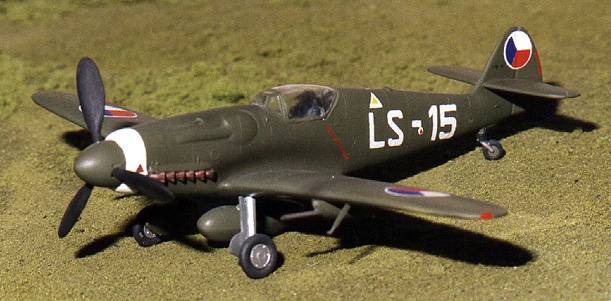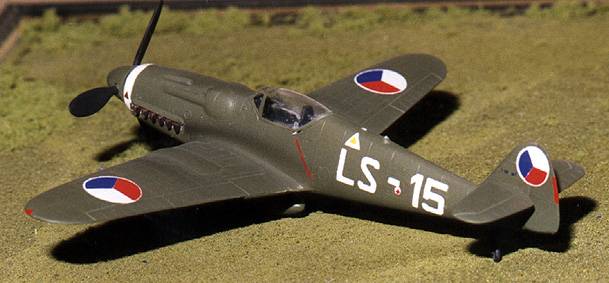
KP 1/72 Avia S.199
Kit Number: 10
Price: $4.00
Decals : Three versions: two Czech AF and one Czech Border Patrol
Date of Review: 11 November, 1996

Another photo at the bottom of the review
Comments: The S.199 was not the last incarnation of the Bf-109 that first flew in 1933, but it was one of the last to see battle. Built in Czechoslovakia after the war by mating a Jumo engine to a Bf-109G fuselage when Czechoslovakia could no longer get Daimler-Benz engines. The aircraft was a complete pig to fly and was not liked by any who flew it. Its main claim to fame was its use in the Israeli war of independence in 1948, where it was flown with distinction by various Israeli and mercenary pilots.
This KP kit was one of their first ones and, like all the other KP kits I have built, is a mixture of good and bad. When one opens the sturdy cardboard box, one finds crisply molded white plastic, a very nice instruction sheet and decals. The detail is very fine raised lines that duplicate every panel and rivet. It is almost a shame to build the kit, especially because the kit is a bit of a hassle to build and requires you to remove some of this detail in sanding.
There is a complete interior, detailed wheel wells and separate exhaust. Upon completion of the interior, I painted it RLM 66 (there must have been lots of unused RLM paints left from the war) and drybrushed it. I should have saved my time as the canopy is thin, but very distorted. The rest of the kit builds in the normal way, but almost all parts needed careful building and putty for many gaps. The plastic used by KP is rather soft so you need to be careful of your sanding and gluing. Once all the airframe parts were assembled and sanded and puttied (ruining that great detail), it was time for painting.
First I put on the canopy, a particularly trying job as it just did not want to fit properly. It looks like a blown replacement for the Galland hood of late war 109s, but either the windscreen is too small, or the hood too big as it just doesn't look right when finally attached. Anyway it was masked, as was the white nose ring and the entire aircraft was painted an overall dark green (I guess it is supposed to be RLM 71). Once dry, it was time for the accessories. The exhaust stacks were painted and attached with no problem as was the big paddle-bladed propeller. The wells were painted RLM 02 grey, and it was time for the undercarriage. Most of the round parts were offset due to mold mismatch (a common problem with KP kits) so the main gear lost a lot of detail. If I had spare 109 parts, I'd have replaced them as the wheel which were plagued by mold offset as well. The strangely shaped fuselage fuel tank was attached and the entire aircraft sprayed with Future in preparation for decals.
KP decals are either too thin or too thick and these were too thick. They were also not very crisp and slightly out of register, but there really was no other option available so I used them. They refused to snug down even with repeated applications of Solvaset.
Even after all these years (1996), this is the only 1/72 kit of the S.199 available. It is required of any serious 109 builder to add this version to the collection. Now all we need is a good 109 prototype and a better kit of the Spanish version than what is provided by Pegasus.
Recommended to those with experience.
